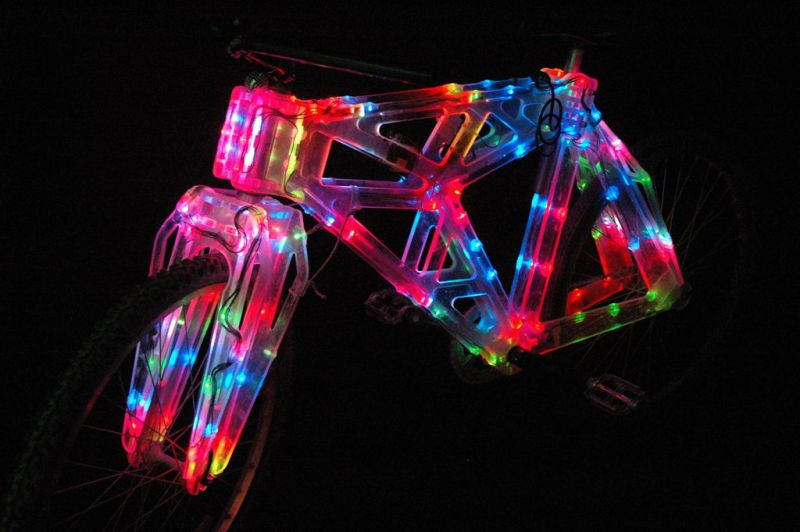Several years ago [dan] saw some plastic frame bikes designed by MIT students. Ever since he saw those bikes he thought it would be cool to make an edge-lit plastic framed bike.
The frame is made from 1/8″ and 3/8″ thick polycarbonate sheet. The parts were designed with tongue and grooves so they fit together nicely. The joints were glued to hold everything together. Holes were drilled in the edge of the plastic large enough to fit an LED. Once the LED was inserted in the hole, it was wired up and secured with hot glue. There are about 200 LEDs on the bike, powered by a constant current LED driver circuit that [dan] designed specifically for this project.
The build process was certainly not flawless. For example, the plastic holding the bottom bracket (where the crank and pedals attach) broke. This can be avoided by increasing the amount of material in that area prior to cutting out the pieces. [dan] was able to fiberglass his broken parts back together.
[dan] admits that the bike is heavy and a little wobbly, but is definitely ride-able. He did us a favor and made all his CAD files available to anyone that wants to make one themselves. If polycarbonate is too expensive for your blood, check out this bike make from cardboard.
















“Step 7: The electrical circuit & programming (overview)
I used a very simple circuit here. the LED’s are in 3 banks. each bank is all one color of led (one bank is red, one is green, one is blue). all the LED’s in a bank are wired in parallel. each bank uses my simple LED constant current source. each bank can be turned on or off using a power mosfet. lastly there is an Atmel AVR microcontroller which turns the 3 mosfets on and off in a few simple patterns, i’ve attached the C code for the microcontroller.”
if the led’s are wired series/parallel, what advantage is there to using a constant current driver source? if one series string fails, the other series strings of the same color get more current– it’s teetering dangerously close to a cascade failure imo..
Not sure it’s street legal though. Where I’m from a bicycle MUST have a clearly defined with front light and a clearly defined red back light.
Not all cities require either of these. It is legal in parts of the world not legal in other. I myself would worry it would crack…
Wow, it finally happened, someone finally crossed a bike with a jellyfish, nice!
I really wonder how much more cracking resistance this has over rock candy or glass.
The bottom bracket is just about the most stressed part there is on a bike. The axle dropouts are next, failure there is always a downer.
there is a very big difference between ‘Nighttime Riding Safety’ and ‘Distracting Other Road Users’
^this
Next step, crossed polarizers for real-time daytime stress analysis :-)